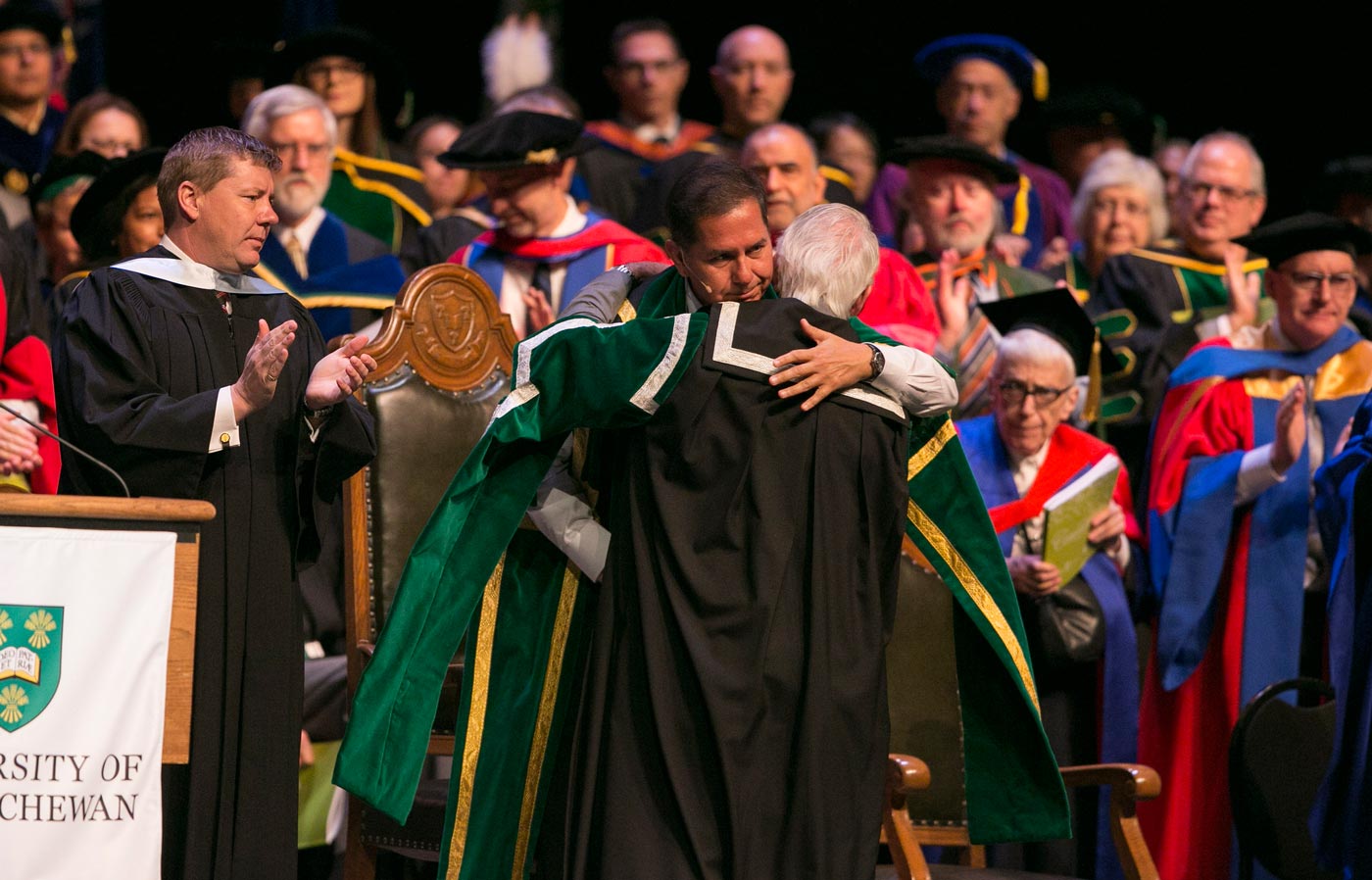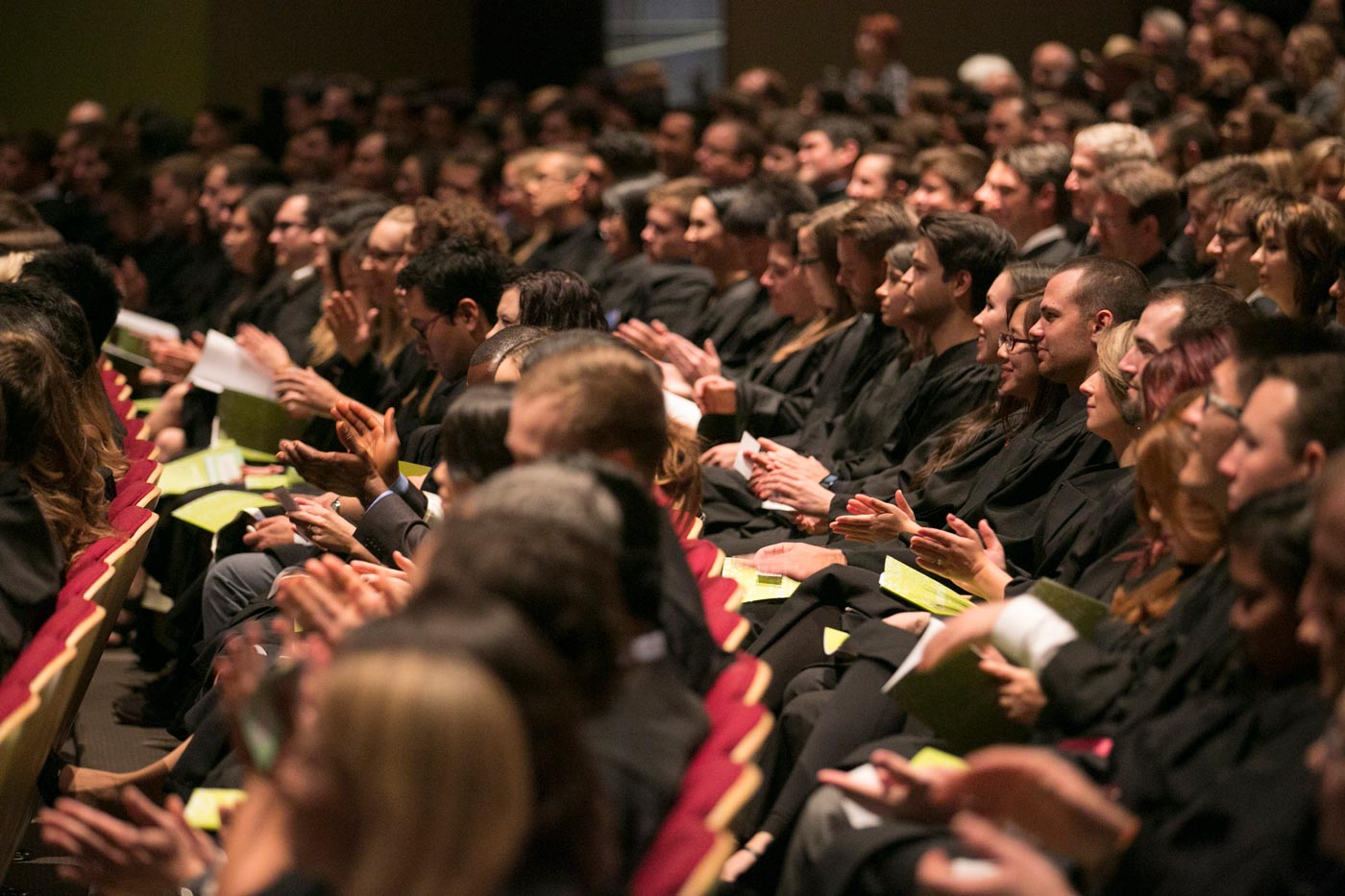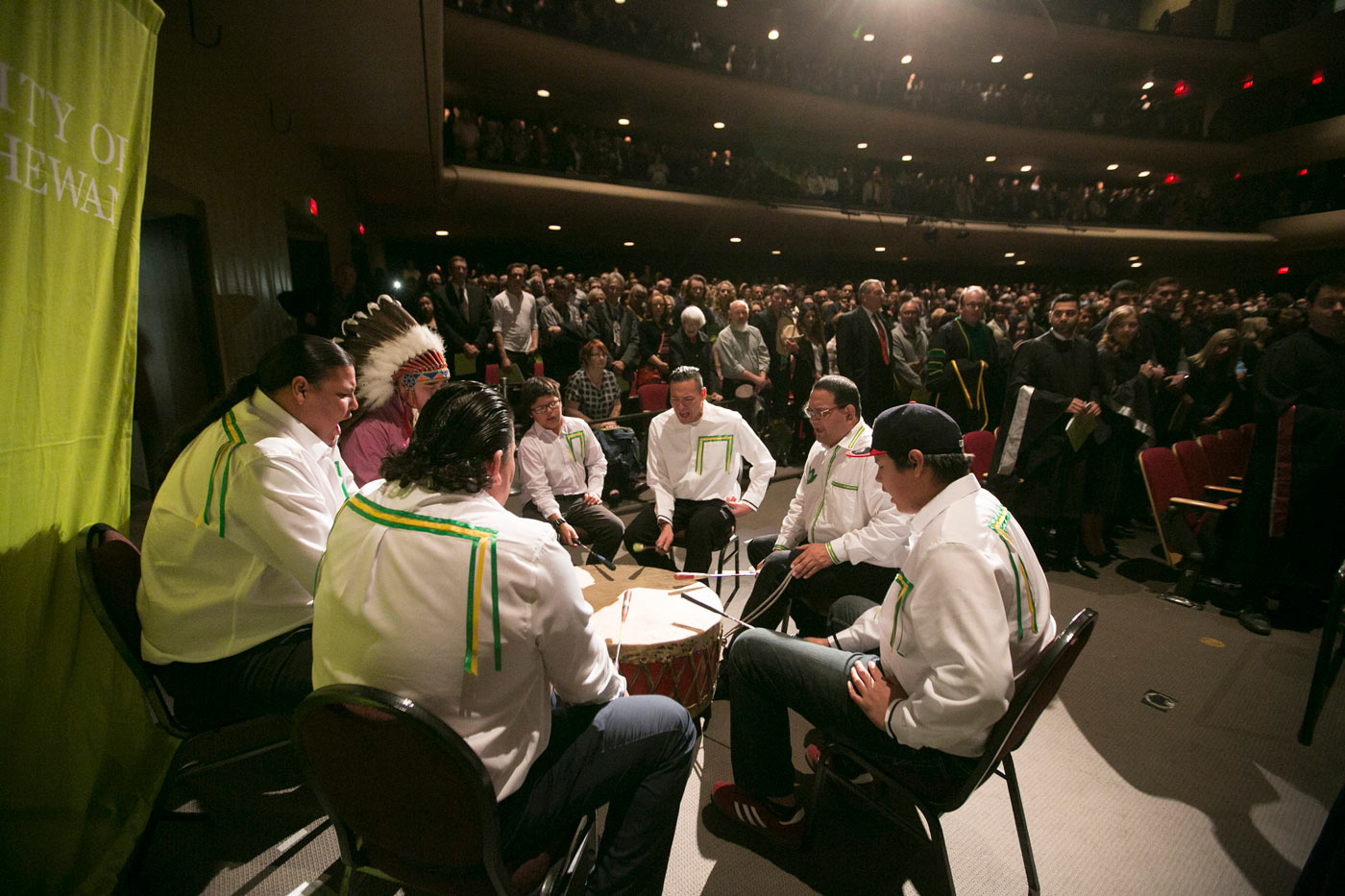Installation address
"Although we do not know what the solutions are to the major global challenges, we do know this-that none of them will be solved by a single discipline or a single person, but by many people from many disciplines working together. We are poised to help do that."
Eminent Chancellor, students and families, honoured guests: I thank the many people who are here today to be part of this moment in the University of Saskatchewan’s history. In particular, I want to acknowledge the presence of the Minister of Advanced Education the Honourable Scott Moe; His Worship the Mayor of Saskatoon Don Atchison; former chancellors Ted Turner, Peggy McKercher, Tom Molloy and Vera Pezer; former premiers Roy Romanow and Lorne Calvert; University of Regina president Vianne Timmons; St. Thomas More president Terrence Downey; Saskatchewan Polytechnic president Larry Rosia; Executive Director of the U15 Group of Canadian Research Universities Suzanne Corbeil; President of Universities Canada Paul Davidson; my wife Kathryn and our children Alixandra and Christopher; my dear friends who are here from New York, Boston and Toronto; and family members from Montana, Calgary and Regina. I would like to thank the many faculty who are here today as well. The presence of everyone demonstrates the significant place the University of Saskatchewan holds in the hearts and minds – in the souls – of the people of this province, this city, Canada and beyond.
And I’m proud to say that as we gather here today, we acknowledge we are on Treaty Six Territory and the Homeland of the Métis. We pay our respects to the First Nations and Métis ancestors of this place and reaffirm our relationship with one another.
This university has been in my imagination for many years—long before I moved here with my wife almost 30 years ago as a new faculty member. Its name would wind through conversations during my childhood in Ottawa where my father, a physicist, worked at the National Research Council. A president of the NRC was from the U of S (there would be another later on), and the Nobel Laureate Gerhard Herzberg with whom my father worked had earlier been a faculty member here for 13 years (Dr. Herzberg’s daughter Agnes is on the stage this morning).
As I went to school and university, I learned the history of the Cobalt 60—built and used here by researchers here like Harold Johns and graduate Sylvia Fedoruk, it was the first in the world to successfully treat a cancer patient using cobalt-60 radiation therapy, revolutionizing cancer treatment and saving the lives of millions of cancer patients around the world. I knew about some of the country’s most formative political leaders associated with the university such as John Diefenbaker, Ramon Hnatyshyn, then afterward of premiers Grant Devine and Roy Romanow and Lorne Calvert, and later Premier Wall.
I knew about graduate students such as Henry Taube who, like Dr. Herzberg, went on to win the Nobel Prize in Chemistry. I knew about writers Sharon Butala and Guy Vanderhaeghe and social scientists like Hilda Neatby, Mabel Timlin, and Norman Ward. About music composers like David Kaplan; artists like Eli Bornstein. I had heard about actors like Henry Woolf and Kim Coates and Carol Greyeyes; and Aboriginal leaders like our chancellor Blaine Favel, former Chief of the FSIN.
Those people, the positive impact they had and continue to have on the lives of others, were in my imagination—the books they wrote, the art they created, the political parties they led, the scientific innovation they drove, the public policy they changed, the leadership they provided. Because of these people, I knew that I wanted to be part of that university.

<a href="https://www.flickr.com/photos/usask/sets/72157659956434418">View more photos</a>
When I arrived here I learned more: the role of the medical college in leading health- care innovation in the province and the world; of the College of Agriculture in leading farming innovation and research with a huge return on investment and improvement in the lives of people of this province and throughout the world; of the Western College of Veterinary Medicine and its prominent role in animal care and research nationally and internationally; the great athletes and coaches who were here and who were trained here; the fact that this is the only major university in Canada with a College of Arts and Science gathering together the fine arts, the social sciences, the humanities and the sciences. There isn’t a music teacher in this province who has not benefitted in some way from our music department and music education program; not a visual artist who has not been associated in some way with our studio art program; not a theatre director or actor or playwright who has not in some way been influenced by our drama department, the first in the Commonwealth.
I learned that we are seen as a research leader in the country, with Canada’s only synchrotron, one of the world’s most advanced vaccine research facilities at VIDO-InterVac; a cyclotron; excellent nursing programs and research; colleges and graduate schools of dentistry, pharmacy and nutrition, kinesiology, education, engineering, business, law, environment and sustainability, public health and public policy, as well as an excellent library system to support their work, and groundbreaking accomplishments and alumni of which they can be proud.
I learned we have one of the widest arrays of colleges and disciplines of any university in the country. This to me is a crucial feature of who we are—because although we do not know what the solutions are to the major challenges facing us today, we do know this—that none of them will be solved by a single discipline or a single person, but by many people from many disciplines working together. We are poised to help do that.
To the graduands here this morning, reflect on these people and colleges and graduate schools and what they’ve contributed, and know that you have earned a degree from an institution with a history of excellence; and by virtue of this, your degree has tremendous value as you move out into the world and make a difference yourselves. For my part, I’m humbled by these people who have gone before us, as we all will be by you; and I see my role to be creating, always, the conditions for that excellence to grow, to be valued, and to be supported.
So this university has a history of excellence and a future of tremendous potential. And that is because it has had students like you this morning who followed a passion during the time they were here and then converted that passion into contribution, into a positive impact on others. They were compelled to do what they’ve done, they were drawn to it, they loved doing it—they saw significance in what they were doing and how it contributed to their communities and beyond. They learned from faculty who were doing research, scholarly and artistic work at a high level, as do the faculty on the stage with me this morning.
Don’t let anyone tell you to drop your dreams of a life of contribution and impact because they seem too big or unrealistic. Seek opportunities to lead change, remembering that you were here to understand how people have thought beyond what they were told was true; you were not here just to accept received wisdom.
You stand at a threshold, like I do this morning, ready to take a step into futures we can only partially discern, with trepidation and excitement—but we will do it with passion and with compassion, the greater measure of us than how much we acquire and consume.

<a href="https://www.flickr.com/photos/usask/sets/72157659956434418">View more photos</a>
Given that the U of S has a past and present of excellence, what is its future? That’s the question we need collectively to answer and to act upon. When the university’s first president, Walter Murray, was traveling to Saskatoon to begin his work here in August of 1908, he wrote to a friend that “we must remember that we are building for centuries.” What is the role of the modern university in a time of change, maybe a time of the greatest change humankind has seen? And what is the responsibility you and I and all of us here carry with us through the great privilege of being part of this university—of having the kind of educational opportunity the vast majority of people in this world can only dream of?
One thing I know from our history is that a university is a place where problems can be solved; challenges can be met; where we see the beauty in truth and truth in beauty; that the arts and the sciences, at their highest levels, aspire to the same end; that creativity and innovation in a university are the fires that stoke the engines of change and that the world needs that creativity and innovation desperately today. And if the world is changing faster than it ever has, and the challenges it faces are arguably the most urgent it has ever faced, I would say universities are needed now more than they ever have been, and that the University of Saskatchewan is needed more now than it ever has been.
We are needed globally. We know at the U of S that our reach is global in selected areas, that we have the expertise to help solve global challenges, particularly around food and water security, infectious disease, and the environment. We were this summer one of only five universities in Canada to succeed in the largest federal research funding program this country has ever created—the Canada First Research Excellence Fund. Not everyone thought we could do it—but we did it because we have the talent, the perseverance and the creativity. And through this research program led by our Global Institute for Food Security we will help many people worldwide to have far greater access to food. The university’s global reach will entail more international partnerships in research, scholarly and artistic work, attracting more students and faculty here from other countries, and all of us benefiting from the intellectual and cultural richness that such diversity brings.
We are needed by this country. Universities like ours, members of the U15, the most researchintensive medical-doctoral universities in Canada, contribute $8.5B in research and educate 550,000 students annually, stimulating innovation and the economy. Collectively, all 100 or so universities in this country contribute $35B and are drivers of economic prosperity. Canada ranks only in the middleof countries worldwide in terms of innovation—a key to all of our futures—and is at risk of being left behind by surging global economies such as India’s, China’s and Brazil’s. Research partnerships with communities, governments and companies are critical to ensuring that discoveries and insights advance our ability to meet social, health and economic needs. Universities like ours hold the expertise to make Canada a leader, not a follower, in this respect.
We are needed by the province whose name we bear, whose current government is planning for growth, whose population is increasing and deserves access to education, talent and creativity, along with careers. The U of S contributes over $1B to the province annually. We must ensure we fulfill these roles and work with all our post-secondary partners in the province to collectively offer the best education we possibly can to the people of Saskatchewan.
We know that we occupy a special place in the imagination of this city—that all great cities need a great university to forge and attract talent. As the world’s population shifts from rural to urban, as it has in Canada recently, our role in the City of Saskatoon, federally designated a cultural capital of Canada and locally dubbing itself “science city”, grows ever larger.
All this tells me that we are regarded as, and need to see ourselves confidently as, an agent of cultural change, building on our community of over 147,000 alumni, countless supporters and stakeholders worldwide, like all of you here, who expect nothing less than that we continue to take our well-earned place among the best. Leading the intellectual, scientific, professional, artistic, medical and environmental enrichment of the people—in short, a cultural institution. That’s our purpose; that’s the place we occupy—as a cultural institution leading transformative change.

<a href="https://www.youtube.com/watch?v=ZHeRmmX3hIc"> Watch</a> | <a href="https://www.flickr.com/photos/usask/sets/72157659956434418">View more photos</a>
It’s an implicit social contract we have with the public to provide an environment for students and faculty to “inquire”; for them to advance knowledge by “informing”; for administrators to sustain the conditions for that to occur; for all of us together, emboldened by that knowledge, to create significant positive change by “innovating.” And also to inquire, inform and innovate because knowledge is something to acquire for its own sake—there’s precious little of it around during times of spiritual need—the deep things are not found just because they’re useful, but because it was possible to find them, because they led us somewhere we couldn’t envision. Literature and history and philosophy—all the humanities—speak to us and must be cherished and studied and taught. The laser was not invented so that the world could play Blu-ray DVDs or scan barcodes or even do new surgical procedures, wonderful as they are, but because someone wanted to see if the naturally scattered state of light waves could be made coherent and parallel. It was a solution waiting for a problem.
So our contract is to inquire, to inform, to innovate. And, in doing those things, to be a dedicated servant to a democratic society and a responsible critic of it. That’s why academic freedom is so important to who we are and what we do—our fundamental legitimizing concept. But there’s a challenge we face in this country that will define whether or not we can say we have fulfilled the mission of the modern university, and it takes the form of the calls to action of the Truth and Reconciliation Commission. We must become the best place we can possibly be for Aboriginal students and their communities in this province and beyond it. That is a crucial role for the modern university in this country, to respond to the most urgent issue of our time and in so doing to play a role in re-imagining Canada.
How can Canada do this if its universities cannot? The University of Saskatchewan has been working to achieve that, but we have not achieved enough, and the TRC’s calls to action make that crystal clear. I can tell you that other universities in this country look to us to make a difference in this regard. They’re doing a lot as well, but they’re also looking to us. And so I ask myself and I ask you, if not us, who? And in the wake of the TRC’s calls to action, and with the country’s 150th anniversary approaching, if not now, when? If not us, who; and if not now, when? That is why I say that this is a university whose future rests on its great potential to inquire, to inform, to innovate—and to indigenize.
We will learn more when Chancellor Favel and I, in partnership with Assembly of First Nations National Chief Perry Bellegarde, host a national forum with Aboriginal, university and student leaders here on November 18-19 that focuses on how to implement the TRC’s calls to action specific to the postsecondary sector. What indigenize means to me is that we rethink, and be open to rethinking, what we mean by inquiring, informing and innovating to become a more welcoming place for Aboriginal students. It is bringing together Aboriginal and non-Aboriginal traditions of inquiring and informing and innovating for everyone’s benefit, in a spirit of tolerance and respect. It means a concerted and cooperative effort to respect, expand and enrich the knowledge systems, ways of knowing, languages, traditions, heritages, and experience of Aboriginal peoples of Canada in tandem with the other knowledge systems of the great minds at the university.
In a moment you will hear a piece performed by the University of Saskatchewan Wind Orchestra, written by the late composer David Kaplan who led the music department for years—its title is Meuwechetuwin and it means “good relations”. It brings together many traditions, Aboriginal and non-Aboriginal, into a musical vision of a way forward for us all.
In this space together this morning, we are part of the exponential power of this cultural institution, this university’s community. I am honoured to be assuming the role as its president and vice-chancellor, privileged that our graduands and their families and all of you are here this morning to share with me in this ceremony. And I am, with all of you, united in a desire to do what’s right, to make a difference, to take our honoured place among the best, and to use that place of privilege for the benefit of all. Together we are building for centuries.

